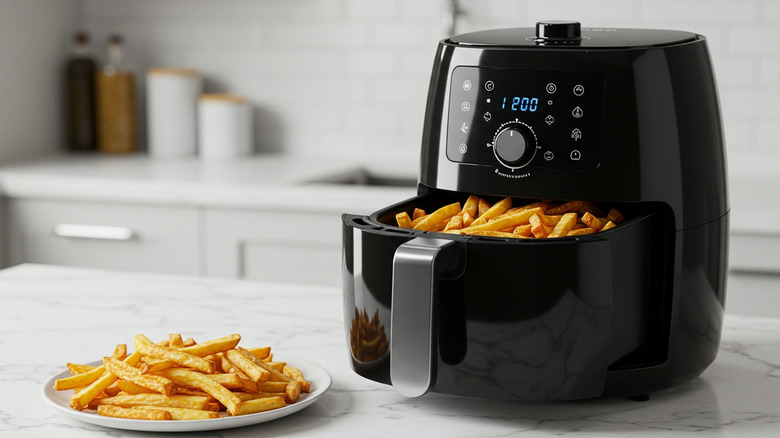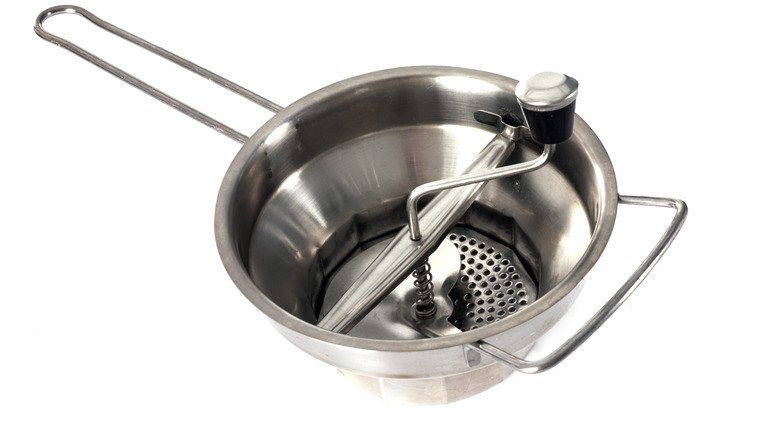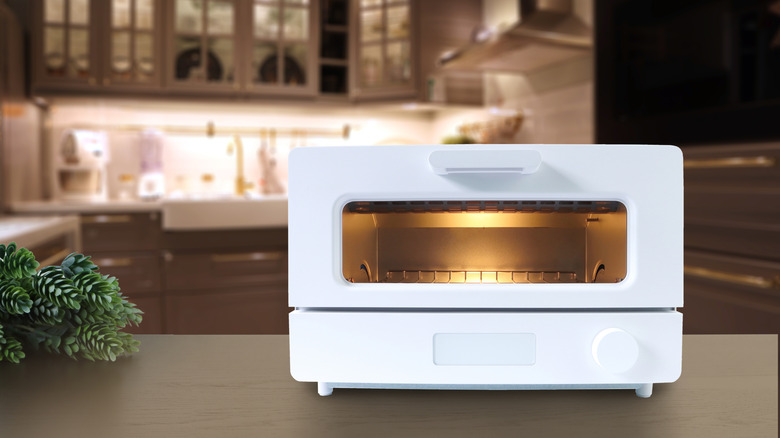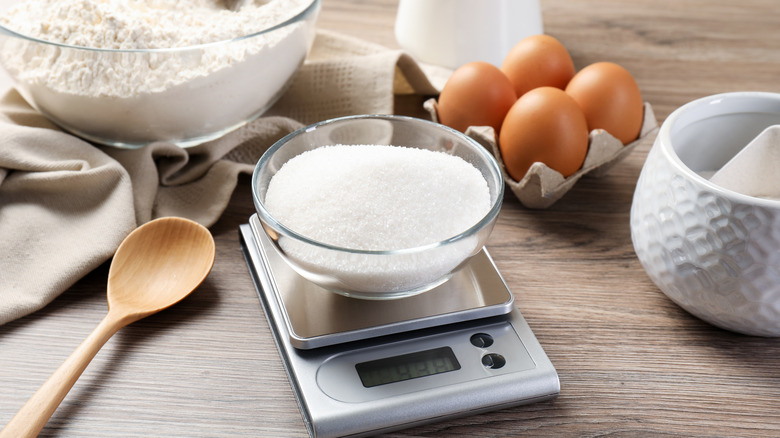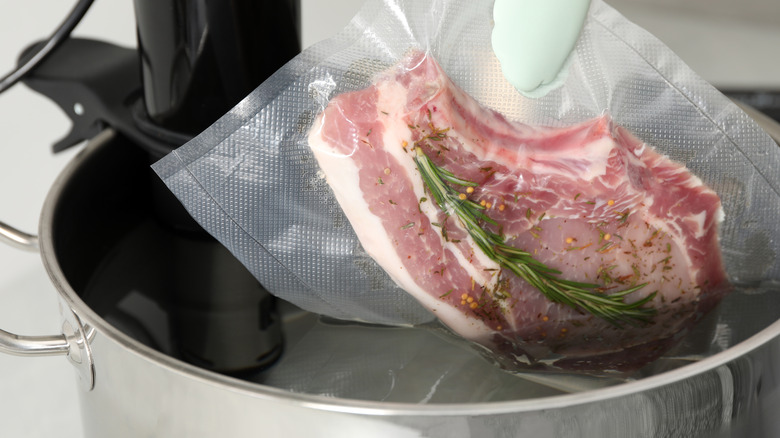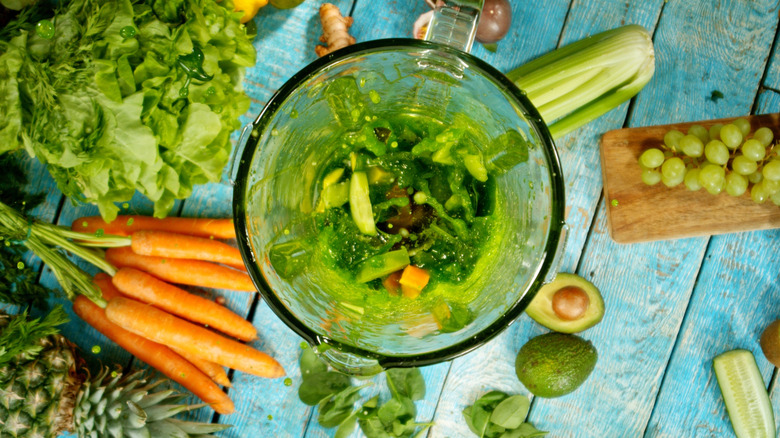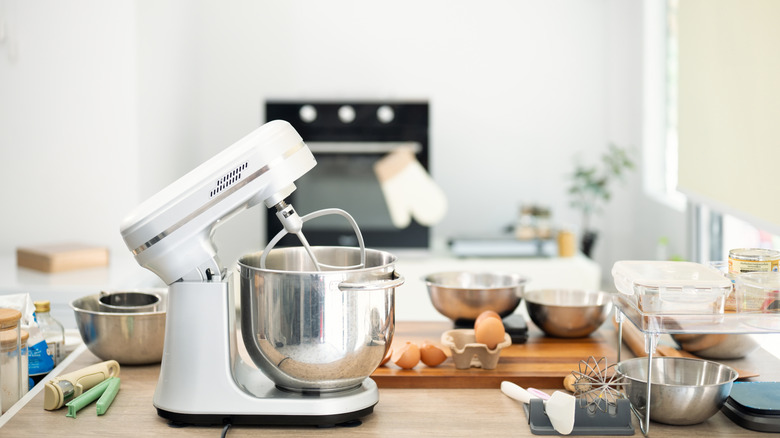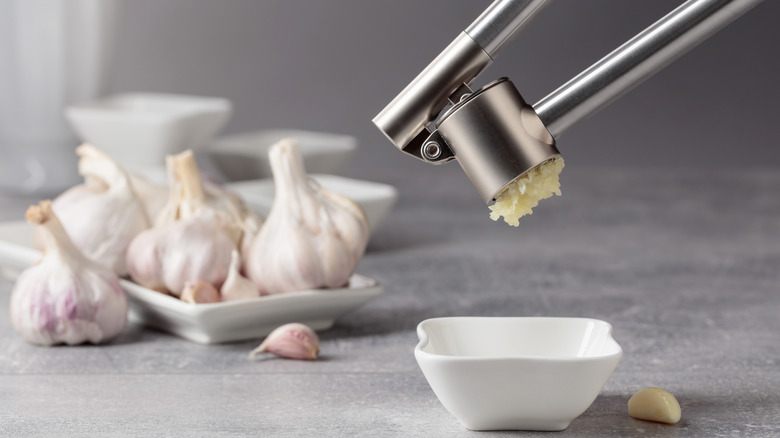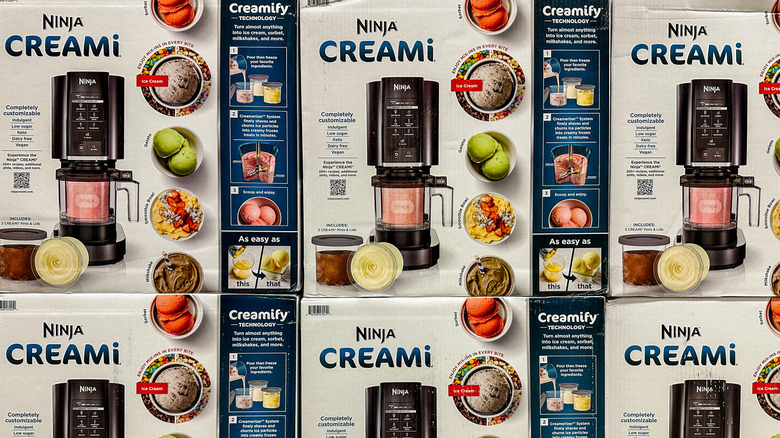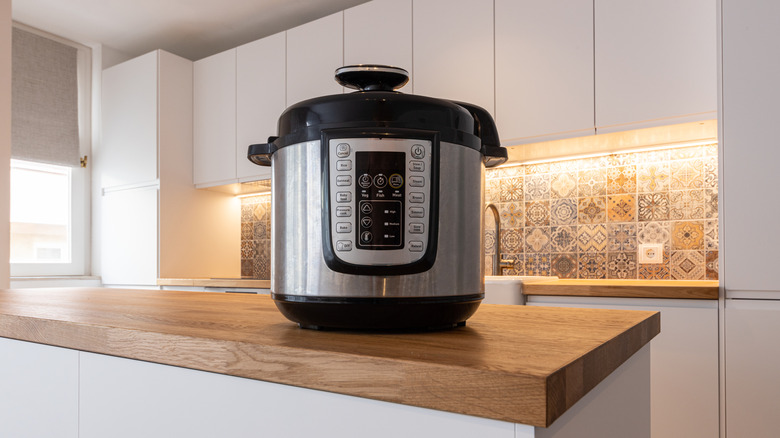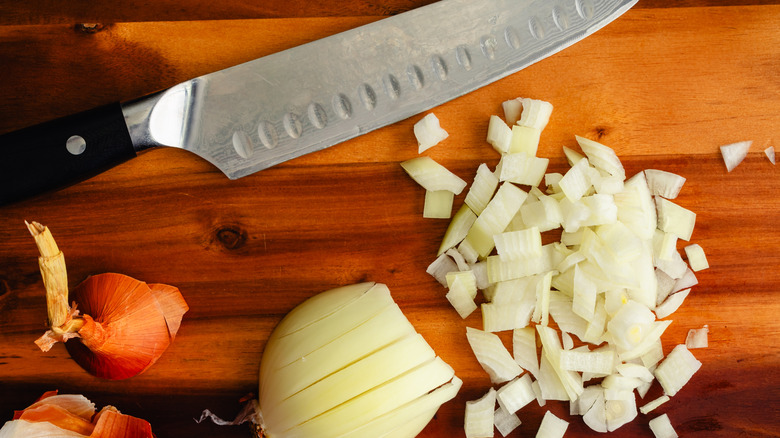We Asked Pro Chefs What Kitchen Gadgets Are Really Worth The Counter Space
Deciding what earns a permanent spot on your kitchen counter can be confusing. To help navigate this jam-packed world of kitchen appliances, we spoke to four experts who know their way around both professional and home kitchens: Michelle Morey, Maine mom and food blogger at Barefoot in the Pines, where she shares her passion for accessible, family-friendly recipes; Ashley Schuering, Nashville-based writer and creator of Confessions of a Grocery Addict, who blends decades of restaurant experience with practical tips; Jessie-Sierra Ross, cookbook author, television contributor, and the creative spirit behind Straight to the Hips, Baby; and chef Kylian Goussot, the culinary force and Executive Chef behind Lafayette Steakhouse and Marion Miami. Together, all four share which appliances are truly worth your counter space — the ones that earn their keep day after day.
As Morey puts it, "If I use it enough that I get tired of putting it away, then it stays." For Schuering, it's about practicality and space: "I have a small 1950s kitchen with limited counter space, so I leave what I use most often on the counter while the rest gets tucked away." When it comes to choosing which gadgets stay in rotation, the rule is simple for Ross: "I tend to judge my kitchen tools by whether they can be used multiple times a week." And finally, chef Goussot emphasizes, "At home, space and equipment are more limited, so efficiency comes from smart organization and multi-purpose tools."
Air fryer
Air fryers first became commercially available in the 2010s, with Philips leading the way. However, those early versions seem positively prehistoric compared to the sleek versions on offer today. Essentially, a mini convection oven, but with a stronger fan allowing for better airflow and faster browning, air fryers promise you healthier food in less time.
According to Michelle Morey, an air fryer is the one gadget that truly earns its place on the counter. "I never put it away, and being a mom, I cook nuggets in it all the time," she told us. "I've also come up with healthier versions of fried food that can be made in the air fryer." She uses the appliance "to reheat pizza, sandwiches, soggy take-out fries... I can't live without that thing."
There are plenty of reasons to consider adding this particular gadget to your kitchen. We tend to underestimate the amount of oil we use when cooking, and air fryers significantly reduce the need for this, almost encouraging you to eat healthier. Apart from this, certain types of food work very well with this type of heating — frozen food, of course, but also smaller baked goods like muffins, toasted sandwiches, wings, and reheated pizzas. This versatility makes the appliance a worthy contender for your precious countertop space, as it does the job of an oven, toaster, and even a microwave. You just need to maximize the potential of your air fryer for the best results.
Food mill
If you think a food mill is only for professional kitchens, think again. While they may look clunky and complicated, in reality, a food mill is a simple kitchen gadget that's perfect for straining and puréeing — but also for much more, as Michelle Morey told us. "They are so underrated and not talked about enough," she said. "I use it all the time during garden season when I have to purée or process a ton of tomatoes. The beauty of the food mill is it catches all the seeds and skins. I don't need to peel a single tomato."
Morey also uses the device for apple sauce. "It literally catches all the skins, and the food mill comes with different-size plates, so you can make whatever you're processing as smooth or chunky as you want," she explained. "And they're cheap."
A food mill consists of a bowl and a perforated disc with small holes, operated by a hand crank. Place the food into the bowl — it could be boiled potatoes, tomatoes, or stewed fruit — and as you turn the handle, the food is forced through the holes, producing a silky purée. It's ideal for making the smoothest mashed potatoes, the creamiest of soups and sauces, fruity jams, and even baby food in a flash. The resulting wastage of pips and seeds is minimal compared to that of a blender, and can be easily composted. So, wins all around.
Toaster oven
When asked to choose only three gadgets for her counter, Ashley Schuering's first pick was her toaster oven, which gets the most use in her small kitchen along with a microwave and hot water kettle. "I love my Breville toaster oven and use it almost daily — during the summer in particular," she told us. "It's more energy efficient than a full oven (smaller, so it doesn't take as long to heat up), and it also won't heat up the kitchen the same way turning on the whole oven does. Not only can it toast to perfection (and hold way more slices at once), it's also big enough (and has settings for) a 12" pizza, broiling a whole chicken, or making a small batch of cookies."
The main benefit of a toaster oven over a regular convection (or fan) oven is that, thanks to its compact size, things get baked and broiled much faster. Many find that the concentrated heat in a toaster oven allows for more even crisping (ideal for salmon skin and pork crackling) in a much shorter time. "It's my preferred way to reheat anything crisp or crunchy, since the microwave tends to soften everything," explained Schuering.
At the same time, the gadget's multi-functionality ensures effective defrosting, evenly melted cheese, fluffy baked potatoes, and even perfect pizzas. "This can easily replace a regular toaster and a bulky air fryer, and has more functionality," said Schuering. What's not to love?
Digital kitchen scale
When we asked our experts about the one tool they reached for that most home cooks underestimate or overlook, the replies were unanimous: The digital kitchen scale topped the list. For Michelle Morey, its a question of convenience. "I hate measuring stuff and dirtying measuring cups, so if there's a weight measurement I can use, I will do that more often than not," she said.
"While a lot of cooking can be done by touch — taking a large pinch of one thing plus a dash of another — baking is different; it's all about the chemistry," explained Jessie-Sierra Ross. "Only a very exact ratio of ingredients will mix together to bake something delicious. If you are a serious home cook or someone who likes to be able to replicate a dish the same way each and every time, a digital kitchen scale is a must-have."
Another reason to add a good quality scale to your lineup is the accuracy of its measurements. While measuring cups are all well and good, a scale can calibrate to a single gram, which can be all the difference between a fluffy loaf of bread or an artistically layered cake and a complete mess. "A digital scale is the simplest way to ensure consistency and accuracy, especially in baking or delicate preparations," said chef Kylian Goussot. So, while it may seem a bit of an investment, the returns will pay off in no time at all.
Sous vide machine
If you were asked what the one tool is that changed the way you cook, what would be your answer? Jessie-Sierra Ross went a little off script when she discovered how a sous vide machine ended up saving her a ton of time. "This small kitchen appliance has completely changed the way I cook large proteins," she said.
Sous vide is a French method of slow cooking vacuum-sealed foods via a water bath, which is heated to a precise temperature. "It is very hands-off, and allows a 'set it and walk away' freedom that makes it the perfect choice when prepping for a party," explained Ross. "The key to this method of cooking is that the sous vide is set for whatever temperature you want the protein to reach. It can never overcook. You can bring a whole prime rib to a perfect medium-rare and keep it there, without fear of overcooking this sometimes-finicky piece of meat."
A glance at online forums shows that many support this view and feel that sous vide machines offer a more refined finished product, even compared to that other trusty (throw-in and leave) gadget, the slow cooker. The results speak for themselves with perfectly cooked sous vide steaks and just-right fish every time. In terms of flavor, unsurprisingly, the technique lends itself to intense tastes and textures, elevating even simple home-cooked food to the next level.
Food processor / blender
Other workhorses in the kitchen are the food processor and blender. Michelle Morey turns to her trusty food processor, "all the time because I hate chopping veggies," she said. "And my version fits in the dishwasher, so it's easy to clean up. I use it to make pesto, chop lots of veggies, make pie dough, scones, and biscuits. It saves me a million hours."
For Ashley Schuering, an immersion blender is a useful and budget-friendly piece of kit. "It's super powerful, plus it came with attachments for a whisk and a mini food processor/chopper, so it does more than just one thing for just over $100," she said. If you want to up your game even further, Schuering recommends a high-speed blender such as a Vitamix or a Blend-Tec for the ultimate results. "These machines are powerful enough to make shaved ice, homemade nut butters, and can even heat raw vegetables into a hot soup," she said. "If you're a 'from-scratch' person, the larger footprint and bulk are worth it."
Chef Kylian Goussot agreed that its versatility makes a high-quality blender a culinary must-have. "From silky soups to smooth purées, fresh sauces, and even quick batters, it's a true multi-tasker," he said. "I prefer tools that serve multiple purposes rather than single-function gadgets that end up collecting dust." No arguments from us on this front. We agree wholeheartedly, and wouldn't be able to function without ours.
Stand mixer
Everyone dreams of a pristine kitchen with a funky-looking stand mixer in the forefront. You don't? Well, we do, and we totally get why our chefs agree. "From kneading bread dough to whipping up fluffy buttercream frosting, my stand mixer is the multi-task workhorse in my kitchen," said Jessie-Sierra Ross. "More powerful than a hand mixer and easier to use, a stand mixer is one of the appliances that never gets put away."
According to Ashley Schuering, a handheld mixer is probably enough for many home cooks, but a larger stand mixer is handy if you bake a lot. "Not only does it give your arms a break, it's also powerful enough to knead bread," she said. "If you get a KitchenAid, you can also buy attachments for everything from making fresh pasta and grinding meat to churning ice cream." Chef Kylian Goussot agrees: "If you bake, a stand mixer is worth the splurge."
Yes, we understand that a good stand mixer is an investment. And that it takes up a significant amount of space, what with its many accouterments and hefty base and bowl (nothing a little planning can't solve). But if you consider that this appliance makes otherwise time-consuming (and arm-aching) tasks such as creaming butter and sugar, whisking eggs, and kneading dough a breeze, the space defends itself. Of late, stand mixers are also available in smaller sizes that are easier to move and ideal for tinier kitchens.
Rubber spatulas / garlic press
Apart from the heavy hitters in the kitchen appliance world, there are some small but mighty additions that our professional chefs swear by. We asked them to spill the beans on budget-friendly gadgets that punch above their weight. Run, don't walk, and nab one (or more) of these if you don't already own them.
Aside from a food mill and kitchen scale, good rubber (or silicone) spatulas are a must-have, according to Michelle Morey. "They're cheap, and they get every single ounce of batter out of a bowl," she said. "They're heat-resistant enough to cook with, and then are so flexible that they work with you, not against you. I especially love the small ones. They get all the contents out of jam and jelly jars. Make sure to get a good one where the head and handle are all one piece. They're easier to clean and they don't break easily."
For Jessie-Sierra Ross, it's all about the humble garlic press. "It sounds so basic, but I use fresh garlic in so many of my recipes, and I hate preparing it by hand (hello? Garlic fingers!)," she said. "I use a heavy metal 2-in-1 garlic mincer and slicer. It's powerful, ergonomic, and dishwasher-safe. At under $20, this is a wonderful small gadget for any cook." Ross is also a fan of "its 'bigger brother', the potato ricer, which produces incredibly smooth mashed potato (or any other root vegetable for that matter)."
Ninja Creami
Last summer, you couldn't scroll fast enough on TikTok to avoid another influencer raving about the benefits of the Ninja Creami. This miraculous appliance was touted as the new breed of ice cream maker, and the Ninja Creami got us all hooked. From giving us the flexibility and creativity to experiment with our favorite flavors to controlling what ingredients went into your sweet treat, the Ninja Creami could do no wrong.
Jessie-Sierra Ross was no different: She fell hard for the Creami, and said she indulges at least weekly in a creamy, delicious treat. "I love the Ninja Creami because I can make my own ice cream bases (basil and lime ice cream, mmmmm), and this handy gadget whips out the perfect ice cream in minutes, without any churning," she explained. "Instead, you freeze your future ice cream into a solid block. Then, the machine 'spins' a blade through it, pulverizing and aerating your base into the most luscious, smooth, and yes, creamy ice cream you've ever eaten. Seriously, the texture is unbelievable, no matter what you put into it."
It's the professional results at home which impressed Ross. "This is a scaled-down version of the machines they use in high-end restaurants to make your dessert sorbet, but it's counter-sized and ready to go when you're craving a sweet treat," she said. "Since you control all of the ingredients, it's also fantastic if you're looking to make delicious low-fat protein ice creams and sorbets." Consider us convinced.
Instant Pot
By now, the Instant Pot is a regular in most households. It has won over hearts by making cooking faster and fuss-free. Throw in a couple of ingredients, choose the program, and within a couple of hours (or when you get back from work) — ta-da! — instant meal waiting for you. The Instant Pot makes rice better than a rice cooker and even cooks cooks ribs to perfection.
"This is another fantastic multi-tasker that can replace multiple appliances," said Ashley Schuering. "While many recipes out there only call for using either the sauté or the pressure-cooking function (which is very useful for cooking things that normally take a long time, much more quickly), there's so much more that you can use it for. I make my own yogurt in it, use it as a slow cooker, and as a rice cooker. You can also get a lid attachment to make more of a traditional air fryer."
This gadget is also touted as being a healthy option to cook with. Here, however, we have to point out that 'healthy' depends on what you put in your recipe. Chicken with butter, cream, and cheese, but cooked in an Instant Pot, doesn't make it healthier. Sad but true. For that, we would need a whole new type of kitchen appliance — one we hope someone somewhere is working toward making a reality.
Chef's knives
Chef Kylian Goussot is clear about the tool he couldn't live without — "a chef's knife with honing steel, because precise cutting is the foundation of cooking in any kitchen," he said. "I recommend investing in a great knife and a sturdy cutting board. They'll instantly improve your cooking and, with proper care, last for years."
If you are confused about whether you need to invest in a chef's knife, here's the breakdown. Unlike more specialized knives, such as paring or boning knives, a chef's knife is meant to be a jack of all trades. A good chef's knife can (and should) be used to dice vegetables, pare and core fruit, and cut meat. Chef's knives can range in size, but if you are starting your home kitchen collection, an 8-inch knife is the most popular choice. When choosing which chef knife to buy, also pay attention to the material and quality.
Needless to say, your knife has to be sharp — and sharpened regularly — to keep it functioning optimally. A blunt knife only means more force and shoddier chopping results. In the end, this affects the flavor and cooking process of your dish. Treat your knives with care and respect, and they'll reward you with years of precise, effortless chopping. Remember, the "professional" label refers to how it's made, not who can use it.

